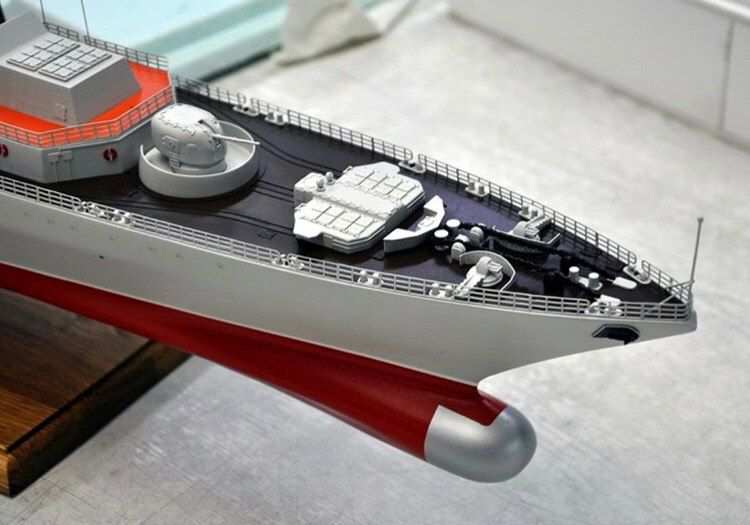There is no space for long missiles under the deck. That's a soviet design with no VLS in mind. UKSK takes away one gun and they still need a plateform to mount the VLS bc of the lenght of the mossiles.
They didn't design the original ships with the idea of upgrading them with new weapon systems that hadn't even been thought of when the original ship was designed... that is hardly a design fault... secondly naval TOR is a vertical launch system, so they did design it with that in mind... replacing the old naval TOR with a new model naval TOR shouldn't be super hard because in the land based version the new missiles fit into the same space as the old ones... in fact they fit twice as many of the new missiles in the same space the old ones took.
The difference is even more noticeable with the old naval TOR missiles as they had a complicated revolving launcher system with one launch hatch for 8 missile tubes that revolved into position under the hatch for launch... having a cell launcher with no moving parts and individual hatches for each launch tube should be much easier and simpler and cheaper and should allow a vast increase in the number of available ready to launch missiles... add to that the fact that the missiles are half the size so you can further double capacity then it is hard to imagine why they wouldn't use an updated tor model... the fact that they are showing new models of Naval TOR proves they are continuing with the missile... it is the point defence missile used on the Kirov class cruisers, the Slava class has the older OSA system that was replaced on land by the TOR system so any upgrades to that ship will likely include TOR, and of course the Kuznetsov uses the TOR system for point defence along with 30mm gatling mounts and Kashtan gun/missile systems...
When tracking the anti ship mossile the FCS will provide an "intercepting"point where to fire the 57mm airburst shell. But that shell will need some few second to travel there. So if the anti ship missile is in evasive manoeuvre mode (generally it starts 15km before the impact so it's te engagement zone of the 57mm gun) the gun will have hard time intercepting it.
Those problems are the same for any gun related interception of an incoming threat. A well designed air bursting shell will create an area in front of the exploding shell where most threats are dealt with... when an incoming threat is detected whether it is pulling 10g or 1g if it is headed towards the ship the 57mm gun is mounted on it needs to be pointing in that guns general direction and is therefore getting closer and closer.
Any manouvers need to result in the target hitting the ship so just any manouvers wont be possible.
Equally if the target is manouvering hard then a TOR missile or a Pantsir missile could be launched to deal with the threat.
If the target is flying straight and level then a quick burst of 3-4 shells to send a cloud of fragments at the incoming target when it is 12km away is worth a shot to stop the threat cheaply and quickly.
You can see in this video from the game war thunder how it is harder to target a target that turns randomly than a target that goes straight. At greater distance it is worse.
I wouldn't be surprised if modern missile have a basic rwr against x band engagemebt radars and know when they are targeted to start manoeuvring.
But random manouvers rely on luck and as I said a threat that is manouvering can be dealt with using manouvering missiles... a 30mm gun is point blank last ditch self defence. A 57mm gun is the same but with better range. A scramjet powered 57mm round might be moving faster at 12km than it was from the muzzle of the gun and with simple command guidance could be a cheap munition to fire... note TOR and pantsir are command guided weapons too...
For the last 2 or 3 km I would prefere to still have the ak630 than just a 57mm gun.
You do understand they know what they are doing?
At 2km range a burst of 200 x30mm shells means 200 chances of a direct hit spread out over 20-30 square metres or more... a single airburst 57mm shell would mean 10,000 chances of a hit over a similar area.
They have missiles for use against manouvering targets...
The AU-220M mount is new-gen tech being designed for new AD units for the modern army & replacing existing 30mm/missile units.
And the point is that the 30mm is too small to have a reliable proximity fuse and enough HE and metal fragments to damage targets over significant distances and even a 200 round burst at 2km means lots of empty space between the shells where small targets like missiles can slip through.
Against bombers or aircraft like a helicopter or an MPA the 30mm is tried and tested and can still do an excellent job.
Even against speed boats and larger vessels or people in the water the 30mm cannon says stop what you are doing and listen to me.
Their defence against supersonic threats has been two stage high speed SAMs and twin 30mm gatling guns.
Their solution for small fast targets is to go for airburst heavier calibres like the 57mm guns in question.
A manouvering 57mm shell can compensate for any manouvers the target might have performed between when the shell was fired to the point of interception and delivering a small HE charge to that target... hopefully to impact or near impact...
Most rounds will be simpler cheaper airburst rounds for use against straight and level stupid targets out to 14km... anything manouvering will need missiles or guided rounds.






